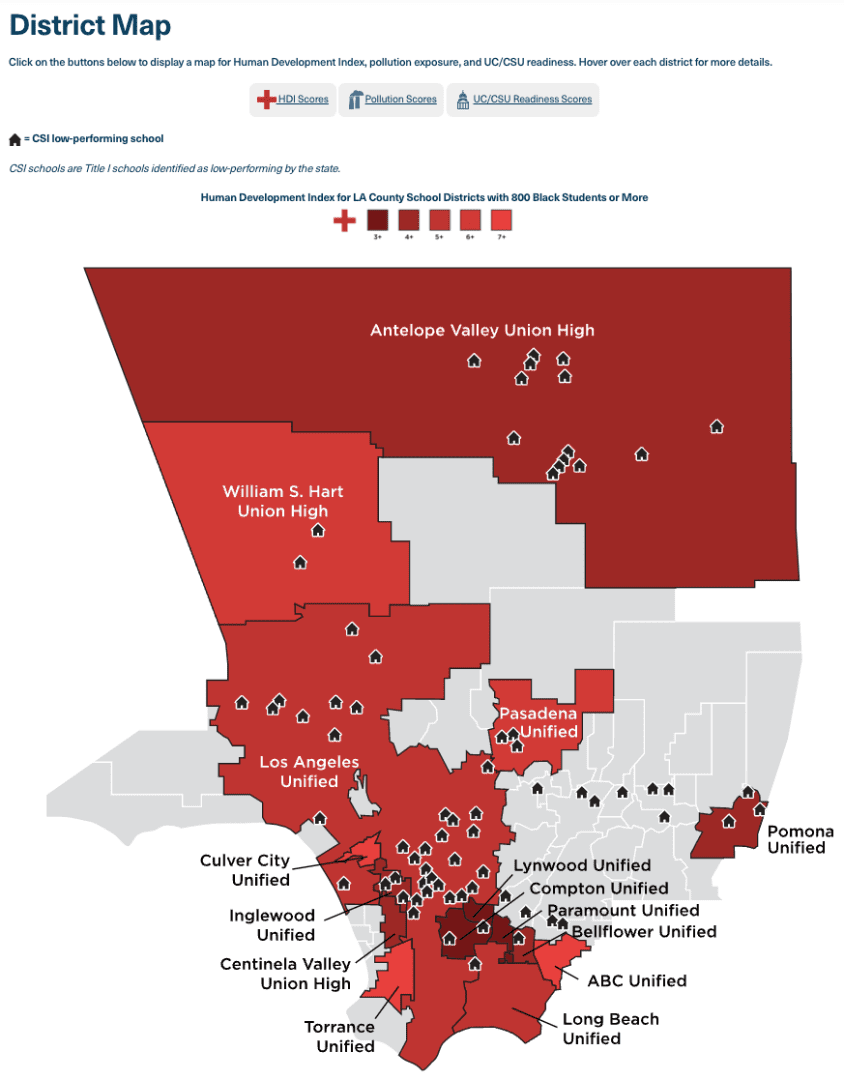Introduction
There are 109,000 Black students in the county, but Black students are overrepresented among those who are underprepared for college, who are subject to punitive forms of discipline, and who are chronically absent from school.
Moreover, a disproportionate number of Black students in LA County attend schools that the state has identified as “low-performing” often where critical resources (e.g. school counselors, nurses, social workers, highly qualified teachers, etc.) are in short supply.
While considerable attention has been focused on efforts to reform schools and raise student achievement, far less attention and effort has been directed at addressing the out-of-school factors that influence a child’s development, or the social and economic conditions in the neighborhoods where they live. We must do both. Throughout this report, we reference the ways in which the accumulation of disadvantage across various educational, health and social indicators interact with the academic and developmental outcomes of Black children in Los Angeles County. Failure to recognize how poverty, health, and educational performance are related has made it more difficult for education policy to have a positive impact on the needs of the most vulnerable children. This report aims to correct this oversight, suggesting solutions that are designed to counter the effects of these disadvantages.
Key Findings
- Place matters: Academic performance and health are highly correlated with where a child lives. Whether or not a child has access to healthy food, parks, clean air or good health services, has a profound influence on their academic performance and the quality of schools they attend.
- The majority of Black students in LA County are enrolled in racially isolated (e.g. predominantly Black and Latinx students) schools located in impoverished communities. For many years, there has been no significant effort to promote racial integration in LA County schools.
- Most of the schools where Black children are concentrated have limited resources despite having high numbers of very disadvantaged students (e.g. students in foster care, students who are homeless, in special education, etc.).
- Key academic and school climate indicators illustrate distinct differences between Black students and students of other racial and ethnic groups.
- Black students who graduate from high school eligible for admission to UC/CSU come from a small number of LA County high schools. With few exceptions, these schools are racially and socio-economically integrated.
- The chronic absenteeism rate for Black students in LA County is 20%, disproportionately higher than for all other racial/ethnic groups.
- Suspension rates for Black students in LA County have declined in recent years, but at 6% it is disproportionately higher than for all other racial/ethnic groups.
- A-G college readiness rates for Black students in LA County is 45%, disproportionately lower than for all other racial/ethnic groups.
- Suspension rates for Black students experiencing homelessness is 6% higher than any other group of students.
- Only 55% of Black male students with a disability in Los Angeles County graduated from high school on time.
- According to the state enrollment report, 9,849 Black students enrolled in LA County schools in the 2005-2006 school year. According to the Four-year Adjusted Cohort Graduation Rate, 3,234 African American Students were UC/CSU eligible in 2017-18, or 32% of the original kindergarten cohort from 2005-2006.
- Social, environmental and health data reveals that Black children and families are more likely to be negatively impacted by their surroundings.
- Districts that enroll the highest proportion of Black students have some of the lowest Human Development Index (HDI) scores in the County.
- The asthma rate for Black children in LA County is 17.3%, almost three times higher than White children (6.1%). Black children in the Antelope Valley and the corridor from South LA to the Port of LA complex have the highest asthma rates.
- 2% of children in the County had elevated levels of lead in blood (higher than 5 micrograms per deciliter of lead in the bloodstream). In South Central Los Angeles, 5.28% of children had elevated levels of lead in their blood.
- More Black families are impacted by food insecurity than any other racial and ethnic group (18%).
- Childhood hardships (e.g. incarcerated parents, homelessness, parental substance abuse, foster care placement) are disproportionately higher among Black students (12%).
Policy Recommendations
There are several relevant factors that influence achievement patterns among Black students that are beyond the scope of this report, such as: under-resourced schools, underprepared teachers, the strength and relevance of the school curriculum, parent involvement, etc. While we acknowledge the importance of these and other issues, we have concentrated our recommendations on areas where new social policies can be adopted and local strategies that can be developed to reduce the educational, social and health disparities for Black students and families. We offer the following recommendations for the purpose of mitigating the effects of adverse childhood experiences (ACEs) and to provide guidance to schools on how to intervene effectively to support Black youth. Lawmakers at each level of government have a distinct responsibility to address historic patterns of inequality, requiring greater coordination and stronger political leadership.

- Work with school districts to provide and coordinate access to resources to support Black families and children (e.g. affordable housing, ensure the safety of neighborhoods, reliability of public transportation, access to job training, and an ongoing effort to address environmental hazards).
- Adopt policies and promote strategies with the County and district officials to identify and remove unsafe community conditions that contribute to asthma, lead exposure, and other health risks.
- Encourage businesses, faith based organizations, and nonprofits to support the development of afterschool programming and community services. Offer more joint programming through recreation and park districts and explore opportunities to share staffing and resources.
- Encourage employers to work closely with schools to develop career and technical education programs in areas where job growth is likely.

- Adopt a Multi-Tiered System of Support (MTSS) framework to reduce suspensions and embrace alternative strategies to punitive discipline.
- Improve student outcomes in A-G courses through guidance and support to teachers and targeted academic support to students in need.
- Coordinate with Los Angeles County Office of Education (LACOE) and local non-profits to ensure that schools serving “high need” populations have access to case managers, social workers, counselors, afterschool programs, mentors and other social supports.
- Develop partnerships with parents and community groups to improve access to adult mentors in districts with shortages of Black staff.
- Hire more Black teachers and administrators where they are underrepresented in schools or district. Develop “grow-your-own” models in partnership with local institutions of higher education.
- Expand access to supplemental educational opportunities including afterschool and summer academic enrichment programs.
- Prioritize system alignment Pre-K-college to improve outcomes for Black youth. There is a need for ongoing collaboration between educational practitioners, leaders, researchers, and policymakers at various levels of the educational pipeline.
- Ensure that financial resources are aligned with district equity and Local Control Funding Formula (LCFF) goals. Any additional funds should be invested in areas of greatest need and in strategies that are likely to have the greatest impact on student achievement and development.

- Create a County-wide strategic plan to address the needs of Black children
- Work with districts to develop a strategic approach to racial and socioeconomic integration in schools.
- Solicit the expertise and perspectives of Black youth, families, community and faith-based organizations regarding their needs.
- Ensure better coordination across departments to ensure more efficient service delivery in high impact communities.
- Engage LACOE in the implementation of the Healthy Neighborhoods Plan in targeted communities and expand upon school-based health centers.

- Invest in an integrated longitudinal data systems to make it possible for the state and County to track the educational progress and health of children, from birth to employment.
- Increase access to high-quality early education programs for Black students and families.
- Provide more targeted funding to augment Local Control Funding Formula (LCFF) in areas where Adverse Childhood Experiences (ACEs), health disparities and environmental are greatest.
- Consistent with the Agenda for California, An African American Perspective:
a) Guarantee access to childcare for low-income families by adding 30,000 slots in 2019-20 and an additional 15,000 slots per year thereafter.
b) Expand the Childcare Bridge Program to meet the needs of young people in foster care and to support them in their transition to independence.
c) Ensure that schools serving the greatest number of students experiencing homelessness receive adequate support. - Support more grow-your-own education preparation programs and state loan forgiveness programs to prepare a diverse, talented and sustainable teaching and leadership force across LA County.

- Expand funding for full-service community schools to support primary health, mental health, and dental care in schools.
- Prioritize funding for Head Start to improve access for Black children and families.
- Increase federal funding to support growing special education costs and to fulfill federal obligations related to IDEA.
Related Work






